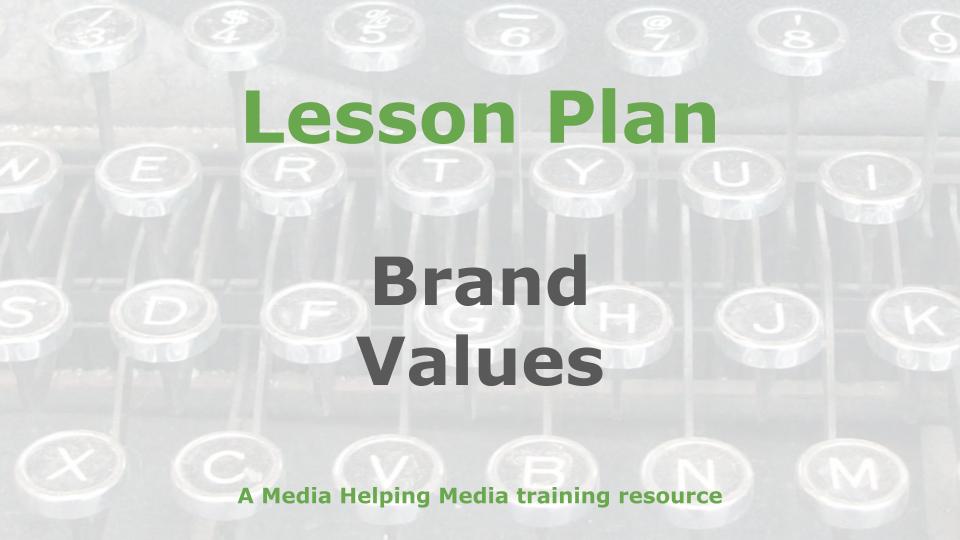 All news organisations have values. They are the biggest part of the organisation’s brand. Journalists need to uphold these brand values at all times.
All news organisations have values. They are the biggest part of the organisation’s brand. Journalists need to uphold these brand values at all times.
Talk about ‘branding’ is relatively new in the history of the news business. You did not hear much about it in the 20th Century.
But now, proprietors and executives are acutely conscious of the need to protect and enhance their ‘news brand’.
Although the language is new, the debate is as old as the industry itself. News providers have always understood the need to stand out in a competitive marketplace. And in the digital age, the competition is fiercer than ever.
Branding is just about making your news product distinctive and connecting with your audience.
And it is not just the high-ups who need to worry about it. It is crucial for the working journalists to understand their news brand and always act in support of it.
One way of thinking about this is to realise that your own news organisation – be it a newspaper, tv or radio station, website or social media outlet – does not really exist.
Don’t worry. It has not been closed down. It’s just that it doesn’t exist in the same way that ‘real’ things exist. Things you can touch, like mountains, oceans, trees, buildings and people.
News organisations, by comparison, are concepts, things that exist primarily in the minds of people. They are ideas and ambitions and objectives that are turned into daily news products.
Above all, they are ideas about values.
Here are a few examples of how famous news organisations define themselves.
The New York Times says: our values are independence, integrity, curiosity, respect, collaboration and excellence.
The BBC says its editorial values include: truth and accuracy, impartiality and diversity of opinion, editorial integrity and independence, serving the public interest, fFairness and privacy.
CNN says its core values are: trust, respect, credibility, creativity, and objectivity.
In other words, the news organisation stands for something. It stands for values.The values are the core element of the news brand.
The idea is that through the brand values, you create an emotional connection with your audience. They start to trust you and you retain that trust by being faithful to the brand.
If you lose the connection by being unfaithful to the brand, you lose the business. The obvious conclusion from this is that the brand IS the business.
In the digital age, competition between news organisations is a battle of the brands. Each one is trying to demonstrate why it is different, better, special.
The battle is fierce and challenging because often the differences between the brands are subtle. Look at the three definitions, above, for example. How well do you think the New York Times, the BBC and CNN have succeeded in identifying unique identities and powerful individual brands for themselves?
There are other components of a brand, including visual things like logos, mastheads and advertising. But with news organisations, everything comes back to the editorial values.
When you are at work, you are a representative of the brand. Your news stories should all reflect the organisation’s values – and so should your personal conduct. Every day at work, you are an ambassador for the brand.
This is not easy. It demands a certain strength of character.
The editor of the dominant UK newspaper of the 20th Century, the Daily Express, said: “I want to spread the idea among the staff that this paper must comport itself with great sincerity in everything it does. We must never be defeatist in approaching the problems of sincere news presentation.”
He was referring to the fact that journalists work under pressure. They write about complex, sensitive and controversial matters and they are under constant pressure to meet deadlines. There is always the temptation to cut corners: to gloss over complications, to “improve” quotes, to massage the facts to fit the story you are trying to tell.
All of this may produce a more sensational, interesting and dramatic story – but it is not consistent with the brand values of a respectable news organisation.
The brand IS the business and the journalist is the ambassador for the brand.

A News brand’s strength lies in its core values
News organisations are, at their essence, constructs of collective understanding rather than tangible entities. While they possess physical manifestations, such as newsrooms, offices, printing presses, digital infrastructure, their true existence resides in the abstract realm of ideas, values, and social contracts with their audiences.
These institutions function as vehicles for shared beliefs about the role of journalism in society, articulating their commitments through editorial choices and journalistic practices.
Understanding this conceptual nature is crucial for any journalist, as it shapes both the responsibilities of the profession and the expectations of the public.
Institutional branding
The defining characteristic of a reputable news organisation is its adherence to a set of core values. These values typically encompass principles such as accuracy, impartiality, integrity, accountability, and service to the public interest.
Though superficially similar across many organisations, these values are expressed with subtle but significant variations, allowing each institution to cultivate a distinct editorial identity and differentiate itself within a crowded media ecosystem.
Such differentiation is essential in an era of intense competition for audience attention and trust. It is through the consistent and faithful application of these values that news organisations establish credibility.
The audience’s trust is not granted automatically; it is earned incrementally through a demonstrable commitment to these principles in everyday journalistic practice.
The relationship between a news organisation and its audience is, therefore, not transactional but relational, based on mutual expectations of reliability, honesty, and ethical conduct.
What this means for journalists
For journalists, this reality carries profound professional implications.
As practitioners operating within these institutional frameworks, journalists function not merely as content producers, but as ambassadors of the brand’s ethos.
Their work serves as the primary interface between the organisation’s stated values and its audience’s perception. Every editorial decision, whether it is choosing what stories to cover, how to frame narratives, which sources to consult, contributes to either reinforcing or undermining the organisation’s integrity and reputation.
This role becomes particularly consequential in the high-pressure environment that characterises much of journalistic work. Tight deadlines, competitive pressures, and the complexities of covering sensitive or controversial topics can create ethical tensions.
In such moments, the temptation to compromise standards for expedience or sensationalism may arise. However, yielding to these temptations risks not only the credibility of the individual journalist but also the reputation of the organisation as a whole.
Sustained public trust hinges on the resilience of journalists to uphold their organisation’s values, even under challenging circumstances.
Moreover, in the contemporary digital landscape, where misinformation proliferates rapidly and audience loyalties are volatile, the distinctiveness and credibility of a news brand are paramount.
Competing for audience engagement requires more than the mere dissemination of information; it demands a clear articulation of why a particular organisation merits trust and attention.
Editorial values are thus not peripheral considerations but strategic imperatives. They function as the ethical framework that informs content creation and as the symbolic capital that underpins brand identity.
Personal branding
For many journalists personal branding has become essential for career resilience amid industry instability. Younger journalists increasingly focus on self-branding to secure autonomy and protect against layoffs, as institutional support wanes.
Social media platforms allow reporters to bypass paywalls and amplify reach, while showcasing their voice to potential employers. However, this shift risks blurring personal/professional identities, with journalists compelled to brand themselves compulsively rather than creatively.
So there is an institutional and individual balance to strike. Media companies benefit from journalists’ personal brands (e.g., expanded reach), but face tensions over social media ownership and brand alignment.
There are also trust reinforcement issues to consider. Both levels combat misinformation, with news brands leveraging trusted environments to boost ad performance and journalists using personal credibility to counter online attacks.
And there are generational divisions with veteran journalists often prioritising institutional branding, while digital-native reporters adopt entrepreneurial self-branding for survival.
In conclusion, the brand identity of a news organisation is inextricably linked to its values, and the maintenance of that identity depends fundamentally on the conduct of its journalists.
Recognising themselves as representatives of these values, journalists carry a dual responsibility: to pursue truth with rigour and to embody the ethical standards of their organisation in both their professional output and public conduct.
In doing so, they sustain the credibility of their institution and reinforce the foundational purpose of journalism, which is to serve the public interest with integrity and fidelity.

Questions & Answers
- Question: What is the fundamental nature of a news organisation beyond its physical presence?
Answer: A news organisation is fundamentally a concept, an idea, and a set of ambitions and objectives, existing primarily in the minds of people and defined by its values. - Question: What is identified as the core element of a news brand?
Answer: The core element of a news brand is its values. - Question: What is the intended outcome of a news organisation consistently upholding its brand values with its audience?
Answer: The intended outcome is to create an emotional connection with the audience, leading to trust and audience retention. - Question: What is the consequence of a news organisation being unfaithful to its brand values?
Answer: The consequence of being unfaithful to its brand values is losing the connection with the audience and ultimately losing the business. - Question: In the digital age, what does the text describe the competition between news organisations as?
Answer: In the digital age, the competition between news organisations is described as a battle of the brands. - Question: Besides editorial values, what other components are mentioned as contributing to a news organisation’s brand?
Answer: Besides editorial values, visual things such as logos, mastheads, and advertising are mentioned as other components of a brand. - Question: What role does a journalist play in relation to a news organisation’s brand?
Answer: A journalist acts as a representative and an ambassador for the news organisation’s brand. - Question: What temptation do journalists often face under pressure that can conflict with a respectable news organisation’s brand values?
Answer: Journalists under pressure often face the temptation to cut corners, gloss over complications, “improve” quotes, or massage facts to fit a story, which conflicts with brand values such as sincerity and accurate news presentation. - Question: What is the primary way a news organisation earns and maintains the trust of its audience?
Answer: A news organisation earns and maintains the trust of its audience through the consistent and faithful application of its core values in everyday journalistic practice. - Question: What dual responsibility do journalists carry as representatives of their news organisation’s values?
Answer: Journalists carry a dual responsibility: to pursue truth with rigour and to embody the ethical standards of their organisation in both their professional output and public conduct.
Lesson plan for trainers
If you are a trainer of journalists we have a free lesson plan: Brand Values which you are welcome to download and adapt for your own purposes.









